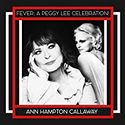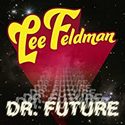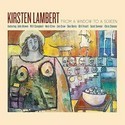|
Different styles and genres share our considered releases this time. We start with Ann Hampton Callaway borrowing the songbook of icon Peggy Lee. Then, another singer-songwriter named Lee (this time it's the person's first name) with a musical of sorts: Lee Feldman's Dr. Future. And since we've marched into March, the month they say "comes in like a lion and goes out like a lamb" and we've come in with the "lionized" star Miss Lee, we'll go out with a Lambert: a singer whose first name is Kirsten and her debut full-length release.
 ANN HAMPTON CALLAWAY ANN HAMPTON CALLAWAY
FEVER: A PEGGY LEE CELEBRATION!
Palmetto Records
CD, Digital
When Peggy Lee sang, she could deliver the essence of sultriness or swing, melancholia or mystique, vulnerability or vivacity. In her splendid tribute to the legend and her material, Ann Hampton Callaway checks all these boxes, resisting thinking too far outside the box to radically reupholster the repertoire. That would miss the point of what she's set out to salute in her set. Fever: A Peggy Lee Celebration! is neither a wholesale hijack nor a simulacrum. Not her first time at this kind of musical rodeo, this velvet-voiced vocalist previously rode her way to success with concerts paying her respects to Barbra Streisand, Linda Ronstadt, Sarah Vaughan, and Ella Fitzgerald. The last two notable nods are also represented by CDs; another Callaway collection, Signature, contains her takes on classics associated with some superstars, including Peggy Lee's hit "Is That All There Is?" (not repeated here, but two of the other numbers included were sung on earlier releases).
One of those revisits is that gem among Jerome Kern/ Oscar Hammerstein collaborations, "The Folks Who Live on the Hill," lavished with emotion, sounding as "shiny and new" as the idyllic cottage it describes, bringing out its glow and glory. "The Glory of Love," the other piece encored, benefits from now being presented as a vocal duet instead of a solo. Having a second voice "agreeing" with the 1936 lyric's big-picture perspective strengthens the lighthearted philosophy, and there's also the happy happenstance of the words referencing "the two of us." The zesty musical partner is John Pizzarelli, who also is playing guitar on this track as he does on "I Love Being Here with You" (co-written by Peggy Lee and Dave Cavanaugh, an executive from her record label, Capitol, who used the pseudonym of Bill Schluger). This makes for a nice second-generation situation as the late guitarist Bucky Pizzarelli worked with Peggy Lee, including being in the band for the few Broadway performances of her long-gestating autobiographical book musical, Peg, in 1983.
This recording pegs five Lee standbys that were included in Peg–including "Fever," done pretty much à la Lee, with some new Callaway words about the honoree's love life–as well as one of its many originals with Paul Horner's music and Peggy Lee's words. (She met the composer when he was the pianist accompanying her and other singers in regional productions of the revue Side by Side by Sondheim.) The Horner/Lee Peg collaboration getting its premiere recording here is the achingly beautiful "The Other Part of Me." This conviction about a pre-destined love is treated with especially tender loving care, via Ted Rosenthal's tip-toe piano surrounding the vocalist's gravitas and grace. It's breathtaking. Sharing similar qualities and approach is the collection's other debut, the marriage of melody and a Peggy Lee poem, "Clair de Lune," given by her granddaughter to Ann Hampton Callaway to set to music.
Other Lee-worded numbers are represented, including songs she sang in films. Two like-minded lyrics are paired in a likable mash-up of optimism: "It's a Good Day" (written with Lee's first husband, guitarist Dave Barbour) and "This Is a Very Special Day" (with her own melody). In a contrasting "feeling mighty lonesome" mindset, "Black Coffee" (Sonny Burke/ Paul Francis Webster), moves on from the Peggy-preferred restraint with its quiet despair and resignation. But it's not the decaf that's being sipped in this energized, worthy new take that nudges frustration to a fuming finale, cued by the line "It's driving me crazy." The bravura ending is a jolt (and jazzy, to boot).
This is a rich, rewarding recital that includes just one of the many Broadway numbers covered by the icon: The Music Man's "Till There Was You," feeling here like more of a warm memory piece than its original theatre context of recent revelation. The sly, slinky and sunny settings are entertaining, but it's the deepest–sweet or bittersweet–heart-on-the-sleeve confessions that are the most impactful. That's no surprise for a singer whose embrace of unabashed sensitivity and rhapsodic romance has long been a strong suit. Intimacy is aided by the subtle work of the trio of pianist Rosenthal, bassist Martin Wind, and drummer Tim Horner. And Fever: A Peggy Lee Celebration! flatters and enhances the histories of both singer-songwriters.
 LEE FELDMAN LEE FELDMAN
DR. FUTURE
Bonafide Records/Urban Myth
CD, Digital
Composer/lyricist Lee Feldman calls his set of songs titled Dr. Future "an imaginary musical," stating that he wants us to listen and let our own ideas flesh out the story and characters. The piece has the same qualities as an earlier musical of his called Starboy, a memorably charming, offbeat science fiction delight. That one resulted in a live concert presentation, an animated film, and a recording reviewed here back in 2006. Mr. Feldman has stated no plans to expand Dr. Future beyond this recording on which he sings all the roles (and plays keyboards, joined by bassist Byron Isaacs and drummer Bill Dobrow). It doesn't play like a traditional musical and there are only hints of a plot. Vocals are folksy, with a low-key, lived-in "everyman" quality.
Lyrics feel rationed in the mostly very short numbers, with not a lot of plot more than hinted at, and many sentences (or partial sentences) simply repeated. Sometimes the words feel more like mantras or someone struggling to communicate or understand something. It makes sense, I guess, for a song called "I Am on Drugs," but I kept hoping for something meaty. Exceptions that veer from this minimalist M.O. can be satisfyingly special; we do get more words in "Words of the Joyless Paintings," "Walk Away," and the nostalgia-tinged "We Was." A number called "Anxiety" brings poignancy ("All my parts are working good as can be expected/ Are you near? I am close and I need you to be detected/ I'm more than the universe/ I'm more than the sky/ I'm more than my feelings").
After my initial listening session, I sighed in acceptance that my priority appetite for lyrics with variety, wordplay and depth would not frequently be sated and I was able to enjoy the tracks more. It's not typically about lyrics doing the heavy lifting or embellishing. The bits of verbiage do economically establish a person, position or point, such as: "I'm a 'Cowboy Looking for Dr. Future' ... My horse died a thousand years ago" and the title character singing,"'My Name Used to Be Bob Stein'/ Now it's Dr. Future." Often the sung lines alternate with strong, equal-length or longer instrumental phrases. Many of them are terrific, catchy nuggets that can be the priority attractions. Evocative and addictive, spiced with electronic "spacey" sound effects, they become bridges to the teaspoon-size servings of words, or vice-versa.
An interactive website is in the works for Dr. Future in the near future to allow a fuller experience and will invite and share reactions. Meanwhile, try a listen and connect the dots for plots of your own.
 KIRSTEN LAMBERT KIRSTEN LAMBERT
FROM A WINDOW TO A SCREEN
CD, Digital
I feel a mix of fondness and some frustration listening to North Carolina-based vocalist Kirsten Lambert's 12-track From a Window to a Screen, but the good news is that her attractive timbre and disarming delicacy make me want to pull up a chair and get pulled in. The never-overpowering band also creates some symbiotic hypnosis. But, with too many tracks of similar tone, timbre and texture, the initially effective affect may become a case of diminishing returns. The musical real estate here is in the N.B.Z. (No Belting Zone) with hushed, wistful observations; the listener becomes the confidant or eavesdropper. Note that all the songs have music and lyrics by Chris Stamey, who also arranged and conducted the strings and is the producer. His palette and style reveal distinctive preferences that are evident as they appear again and again.
"There's Not a Cloud in the Sky" offers a more carefree, welcome change of pace that lightens and brightens the mainly serious and/or romance-soaked repertoire. Kirsten Lambert is admirably convincing in her phrasing, inhabiting intelligent characters with lived-in points of view. Skillful employment of pauses lets her precisely parse words so she (and we) can relish vocabulary, emotions and images in the strongest lines. Here and there, the last word of a phrase in her close-mic delivery is difficult to catch, risking making the musing muddied or seem to be muttered on a first listen. Forming an educated guess about what such a word might be is sometimes stymied with the songwriter's inconsistency about using perfect rhymes.
Chris Stamey's melodies have natural trajectories that flow or become appropriately halting to match the expressed feelings. The lyrics contain some artful, sensory-rich turns of phrase, thoughtfully delivered by the singer. Here are a few that caught my ear: In "What Is This Music I Hear?" there are references to sounds "whispered in a dream" with "sentimental fluff and Gershwin is five thousand miles away." A relationship in the rear view mirror is regretfully summed up as "Guess we ran out of things not to say in our sleep" in the intriguingly titled "27 Years in a Single Day." And the ambiance for "On an Evening Such As This" imagines that "there's an orchestra of 13 kinds of nightingales."
A structural style that becomes formulaic is a penchant for stating and then immediately repeating a key cluster of words for some presumed effect, but often the potential for pithiness becomes predictable and, well, redundant. This is especially exacerbating when the echo is in a chorus that is itself repeated. In From a Window to a Screen's title song, each of three sections ends with the sadder-but-wiser vow of "I won't make that mistake again" intoned twice in a row. In another instance, the spotlighted line is heard three consecutive times.
While this is Kirsten Lambert's first solo album, she's appeared as a guest on others, including chiming in with "Silver Bells" (the Christmas classic that serves as the title for Chris Stamey's holiday project) and was present to present six of these same numbers on his 2019 release of originals, along with other performers, called New Songs for the 20th Century. Although From a Window to a Screen may have me lurching from a smile to a grimace and back again, there is the ring of authenticity in its emotions as written and expressed. It can't be overstated how its more understated moments really resonate.
|
|